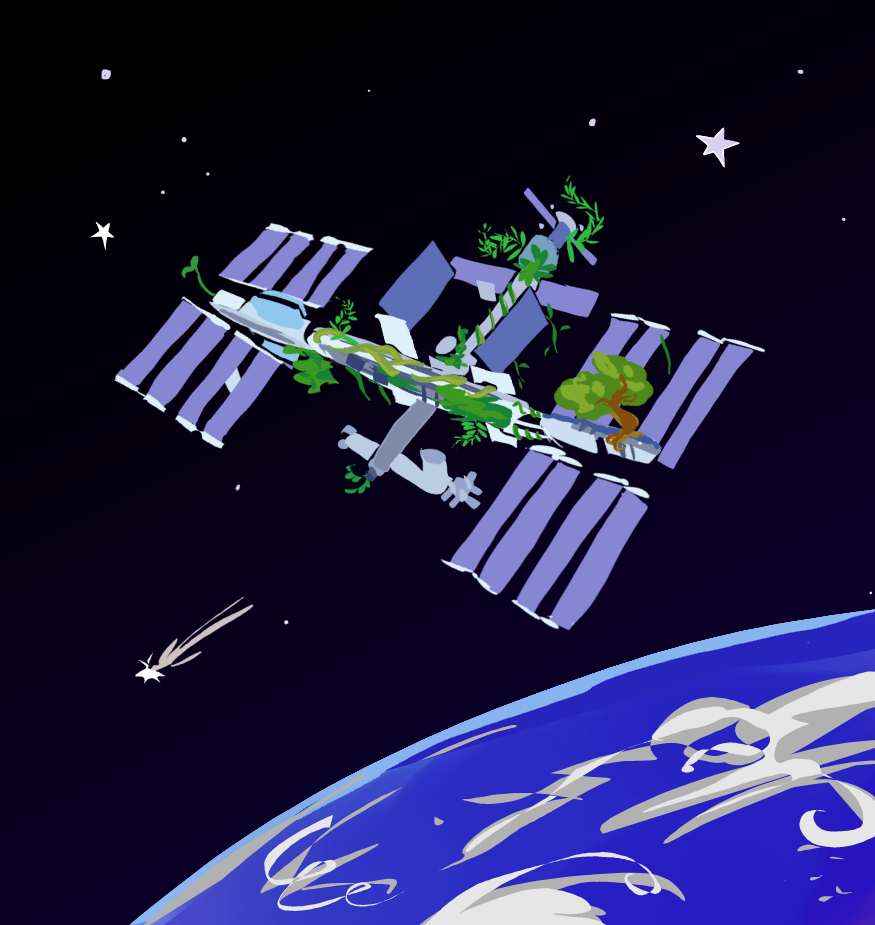Growing Beyond Earth: How Plants Thrive in Space
Scientists are finding ways to grow plants in space to help further research, provide better nutrition for astronauts, and find ways to strengthen crops on earth.
Reading Time: 4 minutes

Walking in New York City, we always see plants growing in the most intricate places: on the sides of buildings, in cracks in the sidewalk, or even underneath cars. All of these plants have one thing in common: they grow in the presence of gravity.
Gravity is important for plants: it allows plants to send their roots downward toward water and nutrients and send their shoots, or the above-ground parts, upwards towards light. Gravity is so essential to plant growth that plants even have their own gravity-sensing cells, called statoliths. Statoliths are starch-filled organelles that are denser than their surroundings and move freely in the cell. When a plant is subjected to gravity, it grows vertically as the statoliths settle in a layer on the basal walls, which are the cell walls at the base of a plant cell, and this contact stimulates proper growth.
However, in places without gravity, statoliths float freely in the cytoplasm, a liquid that fills the cell, preventing the plant from sensing up from down and disrupting normal growth. Despite these challenges, scientists are actively exploring ways to grow plants in outer space under zero-gravity conditions.
There are several ways that scientists are currently growing plants in space. For instance, the International Space Station (ISS) has a space garden called Veggie, a chamber resembling a small greenhouse that produces fresh food for astronauts. In the absence of gravity, these plants grow by using other environmental factors such as light. In the ISS, a bank of LEDs above the plants produces a spectrum of light suited for plant growth. Since many plants reflect green light, the Veggie chamber typically glows magenta pink, which chlorophyll efficiently absorbs for photosynthesis. Growing plants under this colored light maximizes energy absorption for growth and development.
The plants are also grown in a clay-based fertilizer “pillow.” Clay retains water very well, and watering slowly allows moisture to enter deep into the “pillow,” preventing roots from drowning or being engulfed by air. To ensure that the water gets to the roots, a system called aeroponics is used in which water vapor with nutrients is supplied to the roots and lower stem. This is especially useful for plants in space, since it requires only a minimal root system and reduces the need for soil by delivering water and nutrients directly to the roots, leading to faster growth rates and increased nutrient uptake. Furthermore, fans are placed in the chamber to circulate air and prevent gases from collecting in one area, which often happens in weightless conditions, ensuring that the plants receive enough carbon dioxide to grow and photosynthesize.
Scientists are also exploring ways to grow small organisms, such as yeast and microbes, in petri dishes in space using Biological Research in Canisters (BRIC). Scientists use BRIC and LEDs to grow photosynthetic organisms like plants, lichen, moss, etc. Furthermore, BRIC is especially important as it allows researchers to test gene expression in various plants to observe how they adapt to space and any changes in their genomes.
Growing plants in space is important not only for research but also as a source of fresh food for astronauts during long stays on the ISS. For example, it helps give the astronauts a varied diet with fresh greens, radishes, and chillies, along with essential nutrients that frozen dried food cannot provide. The nutrients include, but are not limited to, Vitamin A, K, C, folate, and potassium. The vegetables grown on the ISS mature quickly and thrive in compact spaces, making them an ideal choice. They also reduce the need for frequent restocking missions, making space-grown plants an environmentally friendly solution.
The lack of gravity also disrupts convection, preventing gases from mixing naturally in water. This limits oxygen availability to plant roots and leads to hypoxia, or low-oxygen stress. Through extensive research, however, scientists are working to develop plants that can tolerate low-oxygen conditions on Earth and resist flooding. Researchers have explored solutions such as gene modification and nanobubble technology, which injects tiny oxygen bubbles into irrigation water to combat hypoxia.
Currently, systems like Veggie, BRIC, and the Advanced Plant Habitat—a setup similar to Veggie—are being used to grow crops such as lettuce, arabidopsis, and chillies. However, many challenges and potential risks remain in cultivating food in space. Besides the obvious lack of gravity that can stunt growth, space radiation and high-energy ionizing radiation from the sun can also damage plant DNA, leading to mutations and loss of nutrient value. It can also lead to delayed germination, resulting in smaller plants and reduced seed production. In addition, the lack of a fully contained environment on the ISS creates a high risk of contamination. For example, zinnias grown aboard the station developed a fungus that killed many of the plants in January 2016. While many precautions are taken to protect the plants, many fungi and microbes can still develop.
Despite these challenges, growing plants on the ISS has been done for over 10 years, giving astronauts more nutritious food in space as well as allowing scientists to find ways to strengthen our plant life here on Earth. While it may be a few decades before we get to Mars, it’s comforting to know that there’s a good chance of us having food there to grow and cultivate.
